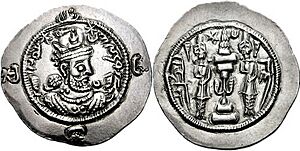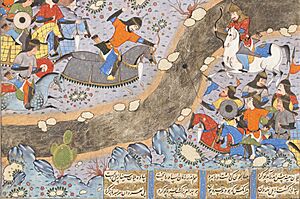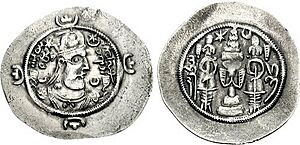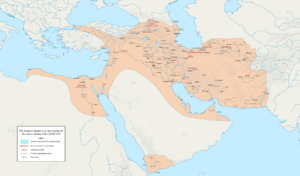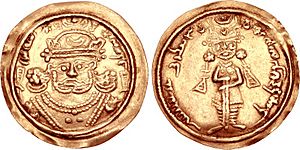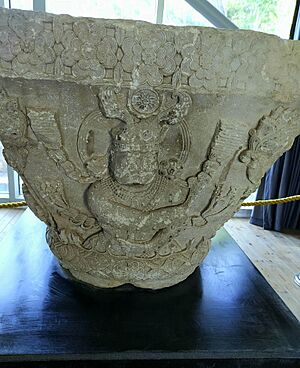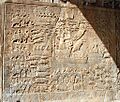Khosrow II facts for kids
Quick facts for kids Khosrow II𐭧𐭥𐭮𐭫𐭥𐭣𐭩 |
|
|---|---|
| King of Kings of Iran and non-Iran | |
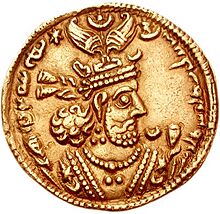
Gold dinar of Khosrow II, minted in 611
|
|
| Shahanshah of the Sasanian Empire | |
| 1st reign | 590 |
| Predecessor | Hormizd IV |
| Successor | Bahram Chobin |
| 2nd reign | 591 – 25 February 628 |
| Predecessor | Bahram Chobin |
| Successor | Kavad II |
| Born | c. 570 |
| Died | 28 February 628 (aged around 57–58) Ctesiphon |
| Consort |
|
| Issue | See below |
| House | House of Sasan |
| Father | Hormizd IV |
| Mother | Unnamed Ispahbudhan noblewoman |
| Religion | Zoroastrianism |
Khosrow II (also known as Khosrow Parviz, meaning "Khosrow the Victorious") was a powerful king of the Sasanian Empire in Iran. He ruled from 590 to 628 AD, with a short break. Many people consider him the last great Sasanian king before the Muslims took over Iran.
Khosrow II was the son of Hormizd IV and the grandson of Khosrow I. His long reign was filled with wars, especially against the Byzantine Empire. He also had to fight against other leaders who tried to take his throne, like Bahram Chobin and Vistahm.
In 602, Khosrow II started a big war against the Byzantines. He said he wanted to get revenge for the murder of his friend, Emperor Maurice. His armies were very successful, capturing many Byzantine lands. This is why he was called "the Victorious." However, a siege of the Byzantine capital, Constantinople, in 626 failed. The Byzantine Emperor Heraclius then teamed up with the Turks and launched a surprise attack deep into Persia.
Because of the long and difficult war, important families in the Sasanian Empire became unhappy. They supported a plan to remove Khosrow II from power. His own son, Sheroe, took over as Kavad II and had Khosrow killed. This led to a period of civil war and chaos in the empire. All the lands Khosrow had gained from the Byzantines were lost.
Khosrow II is a famous figure in Persian literature. Stories like Ferdowsi's Shahnameh and Nizami Ganjavi's Khosrow and Shirin tell fictional versions of his life. These stories often show him as a great hero and a passionate lover. The story of Khosrow and Shirin is a famous romance about his love for Princess Shirin.
Contents
Khosrow's Name
The name "Khosrow" comes from an old Persian word, Husraw. This word means "he who has good fame." In Greek, his name was Chosroes, and in Arabic, it was Kisra. When people call him "Khosrow Parviz," it means "Khosrow the Victorious."
Early Life and Background
Khosrow II was born around 570 AD. His father was King Hormizd IV. His mother was a noblewoman from the House of Ispahbudhan, one of Iran's most important families. Her brothers, Vinduyih and Vistahm, played a big role in Khosrow's early life.
Khosrow's grandfather was the famous King Khosrow I. Khosrow II is first mentioned in the 580s. He was the governor of Caucasian Albania and later of Erbil in Mesopotamia. During this time, he helped turn the Kingdom of Iberia into a Sasanian province.
The Rebellion of Bahram Chobin
King Hormizd IV is Overthrown
In 590, Khosrow's father, King Hormizd IV, angered his general Bahram Chobin. Bahram was a very skilled military leader. He decided to rebel against the king. Many soldiers and nobles joined him because of his high status and military knowledge. Bahram then marched towards the Sasanian capital, Ctesiphon.
The Sasanian kings believed their right to rule came from a special royal glory called the xwarrah. Bahram Chobin, who was from a different noble family (the Parthians), challenged this idea. This was the first time in Sasanian history that someone from a Parthian family tried to take the throne from the Sasanian royal family.
Meanwhile, King Hormizd tried to get help from his brothers-in-law, Vinduyih and Vistahm. But these two brothers disliked Hormizd. They overthrew Hormizd in a peaceful palace revolution. They blinded Hormizd and put Khosrow II on the throne. Later, in the summer of 590, Vinduyih and Vistahm had Hormizd killed. Khosrow II likely approved of this.
However, Bahram Chobin continued his march to Ctesiphon. He now claimed he was coming to avenge Hormizd's death. Khosrow sent a message to Bahram, reminding him that he was the rightful king. Khosrow wrote, "We have taken over the royal throne in a lawful manner... If you wish your welfare, think about what is to be done."
The Fight for the Throne
Bahram Chobin ignored Khosrow's warning. A few days later, he reached the Nahrawan Canal near Ctesiphon. Khosrow's forces were greatly outnumbered but fought bravely. However, they eventually lost morale and were defeated by Bahram Chobin's army.
Khosrow, his two uncles, his wives, and 30 nobles fled to Byzantine territory. Ctesiphon fell to Bahram Chobin, who declared himself king in the summer of 590. Bahram claimed he was restoring the rule of the old Parthian Empire, which the Sasanians had taken over.
Bahram Chobin tried to gain support by linking himself to an old Zoroastrian prophecy. This prophecy said that a savior would appear at the end of Zoroaster's millennium. Many people believed Bahram was this savior. He even minted coins showing himself as a powerful king. However, many nobles and priests still supported Khosrow II, who was the rightful Sasanian heir.
To get help from the Byzantine Emperor Maurice, Khosrow II went to Syria. He asked Maurice for help to get his throne back. Maurice agreed, but in return, the Byzantines would get back several important cities like Amida and Dara. Iran also had to stop interfering in the affairs of Iberia and Armenia.
Khosrow Returns to Iran
In 591, Khosrow prepared to invade Bahram Chobin's lands. His uncles, Vistahm and Vinduyih, gathered an army in Adurbadagan. Khosrow, with Byzantine help, invaded Mesopotamia. Cities like Nisibis quickly joined them. Bahram Chobin's commanders were defeated and killed.
Khosrow II and the Byzantine general Narses pushed deeper into Bahram's territory. They captured Dara and Mardin in February, where Khosrow was again declared king. Soon after, Khosrow sent his supporter Mahbodh to capture Ctesiphon, which he successfully did.
At the same time, an army of 8,000 Iranians and 12,000 Armenians invaded Adurbadagan. Bahram Chobin tried to convince the Armenian general, Mushegh II, to betray Khosrow. Bahram promised the Armenians a partnership in his new empire. But Mushegh refused the offer.
Bahram Chobin was defeated at the Battle of Blarathon. He fled eastward with 4,000 men. He crossed the Oxus river and was welcomed by the Khagan of the Turks. Bahram joined the Turkic army and achieved more military successes. However, Khosrow II felt unsafe as long as Bahram was alive. Khosrow managed to have Bahram assassinated, reportedly by bribing members of the Turkic royal family. The remaining supporters of Bahram Chobin joined the rebellion of Vistahm.
Strengthening the Empire
Domestic Affairs and Relations with Byzantines
With Khosrow back on the throne, he focused on strengthening his rule. He showed tolerance and support for his Christian subjects. His wife, Shirin, who was Christian, was very influential. She helped Mesopotamian Christians gain royal favor. She even had a church and monastery built near the palace in Ctesiphon.
For the first eleven years, Iran and the Byzantine Empire had good relations. They worked together to solve problems, especially in Armenia. Armenian nobles often sought safety in Iran to avoid being forced into the Byzantine army. The open borders allowed nobles to move freely between empires.
The Revolt of Vistahm
After his victory, Khosrow rewarded his uncles, Vinduyih and Vistahm, with important positions. Vinduyih became treasurer and first minister. Vistahm became the military commander of the East. However, Khosrow soon decided to execute his uncles. He wanted to distance himself from his father's murder. He also mistrusted powerful nobles. Vinduyih was soon killed.
When Vistahm heard about his brother's murder, he openly rebelled. Vistahm claimed he had a better right to the throne because of his Parthian heritage. He said, "You are not worthier to rule than I am." Vistahm's revolt quickly gained support from local nobles and former soldiers of Bahram Chobin. He even married Bahram's sister, Gordiya.
Vistahm fought off several attempts by Khosrow's loyalists to defeat him. He soon controlled the eastern and northern parts of the Iranian Empire. He even campaigned in the east, defeating two Hephthalite princes. Vistahm's rebellion lasted for seven years.
Khosrow sent several armies against Vistahm, but they couldn't achieve a clear victory. Vistahm and his followers retreated to the mountains. Some Armenian soldiers in the royal army even joined Vistahm. Finally, Khosrow asked the Armenian general Smbat Bagratuni for help. Smbat fought Vistahm near Qumis. During the battle, Vistahm was murdered at Khosrow's request. However, Vistahm's troops still managed to defeat the royal army. It took another expedition by Smbat the next year to finally end the rebellion.
Ending the Lakhmid Dynasty
In 600, Khosrow II executed Al-Nu'man III, the king of the Lakhmids. The Lakhmids were an Arab kingdom that served as a buffer state for the Sasanians on their western border. Khosrow likely did this because the Arab king refused to give him his daughter in marriage. After this, the Sasanian government took over defending the western borders. The Lakhmid buffer state disappeared. This made it easier for the Muslim Caliphs to invade and conquer Iraq later, after Khosrow's death.
Byzantine–Sasanian War (602–628)
Early Iranian Victories
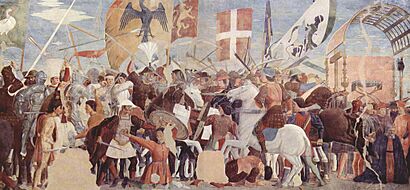
At the start of his reign, Khosrow II had good relations with the Byzantine Empire. But in 602, Emperor Maurice was murdered by his general Phocas. Phocas took the Byzantine throne. Khosrow then launched a huge attack against Constantinople. He claimed he was avenging Maurice's death, but he clearly wanted to take over as much Byzantine land as possible.
Khosrow II, along with his best generals like Shahrbaraz, quickly captured Dara and Edessa in 604. They also took back lands lost in the north. This brought the Sasanian-Byzantine border back to where it was before Khosrow gave land to Maurice. After reclaiming these lands, Khosrow let his generals, Shahrbaraz and Shahin Vahmanzadegan, lead the military operations.
The Sasanian armies invaded and plundered Syria and Asia Minor. In 608, they reached Chalcedon, near Constantinople. In 610, Heraclius rebelled against Phocas, killed him, and became the new Byzantine Emperor. Heraclius tried to make peace with Khosrow II, but Khosrow refused. He even had the Byzantine diplomats executed.
In 613 and 614, General Shahrbaraz captured Damascus and Jerusalem. The True Cross, a very important Christian relic, was taken as a trophy. Soon after, Shahin marched through Anatolia, defeating the Byzantines many times. He conquered Egypt in 618. The Byzantines could not fight back much because they had internal problems. They were also being attacked by the Avars and Slavs from the north. By 622/3, Sasanian forces captured Rhodes and other islands, threatening Constantinople by sea. Heraclius was so desperate that he thought about moving the government to Carthage in Africa.
Turkic Invasion and Byzantine Comeback
Around 606/607, Khosrow called Smbat IV Bagratuni from Sasanian Armenia. He sent Smbat to fight off the Turkic-Hephthalites. These groups had raided as far as Spahan in central Iran. Smbat, with help from an Iranian prince, drove the Turko-Hephthalites out of Iran. He also plundered their lands in eastern Khorasan. Khosrow gave Smbat the special title Khosrow Shun, meaning "the Joy of Khosrow."
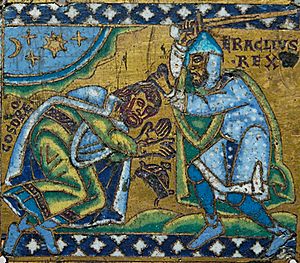
In 622, even though the Sasanians were winning in the Aegean Sea, Emperor Heraclius gathered a strong army. In 624, he marched into northern Adurbadagan. There, he was welcomed by Farrukh Hormizd and his son Rostam Farrokhzad, who had rebelled against Khosrow. Heraclius then sacked several cities and temples, including the Adur Gushnasp fire temple.
In 626, Heraclius captured Lazistan. Later that year, Shahrbaraz tried to capture Constantinople with the help of Avar and Slavic allies. In this siege, the combined forces failed to take the Byzantine capital. The Avars lacked the patience and technology to conquer the city. Also, the Iranians, who were good at sieges, couldn't get their troops and equipment across the Bosphorus strait to their allies because the Byzantine navy guarded it heavily. The strong walls of Constantinople were also easy to defend. The lack of supplies eventually made the Avars give up the siege. Shahrbaraz's forces were defeated, and he pulled his army out of Anatolia in 628.
After the Third Perso-Turkic War in 627, Heraclius defeated the Iranian army at the Battle of Nineveh. He then marched towards Ctesiphon. Khosrow II fled from his favorite home, Dastagird, without fighting. Heraclius captured and plundered Dastagird.
Khosrow's Downfall and Death

After Dastagird was captured, Khosrow's son, Sheroe, was freed by powerful noble families. These included Farrukh Hormizd, Shahrbaraz, and Varaztirots II Bagratuni. On the night of February 25, the guards in the Sasanian capital of Ctesiphon shouted Sheroe's name instead of Khosrow's. This showed that a coup d'état (a sudden takeover of power) was happening.
Sheroe, with his army, captured Ctesiphon and imprisoned Khosrow II. Sheroe took the new royal name Kavad II. He ordered his general, Aspad Gushnasp, to accuse Khosrow of many wrongdoings. Khosrow, however, denied all the accusations.
Kavad II soon ordered all his brothers and half-brothers to be killed, including Mardanshah, who was Khosrow's favorite son. Killing all his brothers, who were "well-educated, valiant, and chivalrous men," left the Sasanian dynasty without strong future leaders. This act has been called a "mad rampage." Three days later, Kavad ordered Mihr Hormozd to execute Khosrow. However, Kavad also had Mihr Hormozd killed after his father's death.
Khosrow's daughters, Boran and Azarmidokht, reportedly criticized Kavad for his cruel actions. Kavad then felt regret. With the support of Iranian nobles, Kavad made peace with the Byzantine emperor Heraclius. The Byzantines got back all their lost territories, their captured soldiers, and a large payment. They also got back the True Cross and other holy items taken from Jerusalem in 614.
Kavad's actions are seen as a turning point in Sasanian history. Some scholars believe his reign played a key role in the fall of the Sasanian Empire. Khosrow's overthrow and death led to a chaotic civil war. Powerful nobles gained full control and started forming their own governments. The old rivalries between Persian and Parthian noble families also restarted, dividing the nation's wealth. The civil war finally ended when Khosrow's eight-year-old grandson, Yazdegerd III, became king. However, the young king inherited an empire that was falling apart. It was finally conquered by the Arabs in 651.
Religious Policies
Khosrow II, like other Sasanian rulers, followed Zoroastrianism, the main religion of Iran. However, Sasanian kings knew that religious minorities were important. They tried to treat all citizens fairly under the law. Jews and especially Christians saw themselves as part of the nation.
During Khosrow's reign, there was often conflict between different Christian groups, the Monophysites and Nestorians. Khosrow favored the Monophysites. He even ordered all his subjects to follow Monophysitism, perhaps influenced by his wife Shirin and his doctor, who were both Monophysites. Khosrow also gave money and gifts to Christian holy places.
Khosrow's tolerance towards Christians and his friendship with the Byzantines even made some Armenian writers think he was Christian. His positive policy towards Christians, which was probably for political reasons, made him unpopular with Zoroastrian priests. But it also helped Christianity spread widely in the Sasanian Empire. During his war with the Byzantines, Christian leaders and groups became part of the Sasanian system. This was part of his plan to absorb the Byzantine Empire into his expanded empire. Christian nobles reached their highest status under Khosrow.
Khosrow also supported Zoroastrians and had many fire temples built. However, the Zoroastrian church was declining during his reign. According to one historian, the Zoroastrian church under Khosrow "was noted for its devotion to luxury more than its devotion to thought."
Music in Khosrow II's Time
Khosrow II's reign is considered a golden age for music. Many Sasanian kings before him, like Khosrow I and Bahram Gur, were also very interested in music. Famous musicians during Khosrow II's time included Barbad (Khosrow's favorite court musician), Bamshad, Sarkash, and Nagisa.
Rock Carvings
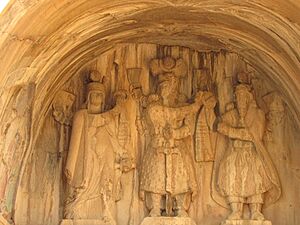
Khosrow brought back the practice of carving large images into rocks. This had not been done for almost 300 years. At Taq-e Bostan, Khosrow created a large rock carving called the "Great Ayvan" (a type of hall). It is carved into a cliff.
The ayvan has two parts. The top part shows a scene where the Zoroastrian gods Ahura Mazda and Anahita are giving Khosrow a royal headband. The bottom part shows Khosrow II on horseback, wearing full armor and holding a spear and shield. A halo around his head likely represents his xwarrah, or kingly glory. On the left side, there is a scene of a boar hunt, showing Khosrow on a boat with a bow. On the right, there is a deer hunt scene. The carving is unfinished, probably because of Khosrow's later defeats in the war and his downfall.
Coins of Khosrow II
During his second reign, Khosrow added the symbol GDH, meaning xwarrah ("royal splendor"), to his coins. He combined this with the word abzōt ("he has increased"). So, the full inscription read: "Khosrow, he has increased the royal splendor." He also brought back the title of King of Kings on his coins. This title had not been used since the reign of Peroz I. This was likely a way to show that he was bringing back the glory of the ancient Achaemenid Empire. His two successors, Kavad II and Ardashir III, did not use this title.
Khosrow II in Islamic Stories
Islamic tradition tells a story about Khosrow II (called Kisra in Arabic). It says that the Islamic prophet Muhammad sent a messenger, Abdullah ibn Hudhafah as-Sahmi, to Khosrow. The messenger carried a letter asking Khosrow to accept Islam.
The story says Muhammad's letter began:
"In the name of Allah, the Beneficent, the Merciful.
From Muhammad, the Messenger of Allah, to Kisra, the great (leader/head) of the Persians. Peace be upon him, who seeks truth and expresses belief in Allah and in His Prophet and testifies that there is no god but Allah and that He has no partner, and who believes that Muhammad is His servant and Prophet. Under the Command of Allah, I invite you to Him. He has sent me for the guidance of all people so that I may warn them all of His wrath and may present the unbelievers with an ultimatum. Embrace Islam so that you may remain safe (in this life and the next). And if you refuse to accept Islam, you will be responsible for the sins of the Magi."
Islamic tradition states that Khosrow II tore up Muhammad's letter. He said, "A pitiful slave among my subjects dares write his name before mine." He then ordered Badhan, his governor in Yemen, to send two men to bring Muhammad to him.
When Abdullah ibn Hudhafah as-Sahmi told Muhammad how Khosrow had torn his letter, Muhammad said, "Even so, Allah shall destroy his kingdom." Later, Badhan's men arrived in Medina and told Muhammad to come with them to Khosrow II. Muhammad reportedly changed the subject, asking why they shaved their beards and left their mustaches long. When they said their god ordered them to do so, he said his god ordered him to cut his mustache and grow his beard.
The next day, Muhammad told them that Khosrow II had been killed by his own son. Badhan's men were angry and threatened to tell Badhan what Muhammad had said. Muhammad told them to write to Badhan and also tell him that Islam and its power would reach all the lands Khosrow II had ruled. A few days later, Badhan received confirmation from Persia that Khosrow II was indeed dead. Because of this, Badhan is said to have accepted Islam.
Khosrow II in Art
The battles between Heraclius and Khosrow are shown in a famous old painting by Piero della Francesca. It is part of the History of the True Cross series in a church in Italy. Many Persian miniature paintings also show events from Khosrow's life, such as his battles or his assassination.
Family
Khosrow was the son of Hormizd IV and a noblewoman from the House of Ispahbudhan. He had two cousins from this family, Mah-Adhur Gushnasp and Narsi. He also had a brother-in-law named Hormuzan, a Sasanian nobleman who later fought against the Arabs.
Khosrow married three times. His first wife was Maria, the daughter of the Byzantine emperor Maurice. She was the mother of Kavad II. His second wife was Gordiya, the sister of Bahram Chobin, and she had a son named Javanshir. His third wife was Shirin, who gave birth to his favorite son, Mardanshah.
Khosrow also had other children: Borandukht, Azarmidokht, Shahriyar, and Farrukhzad Khosrow V. All of these children, except Shahriyar, later became rulers of Iran during the civil war after Khosrow's death. Khosrow had a brother named Kavad and a sister named Mirhran. Mirhran was married to the Sasanian general Shahrbaraz and had a son named Shapur-i Shahrvaraz. Khosrow's brother Kavad had a son named Khosrow III.
Family Tree
| Khosrow I (531–579) |
Shapur († 580s) |
||||||||||||||||||||||||||||||||||||||||||||||||||||||||||||||||||||
| Hormizd IV (579–590) |
Unknown | Vistahm (590/1–596 or 594/5–600) |
Vinduyih | Unnamed noblewoman | Jushnas | ||||||||||||||||||||||||||||||||||||||||||||||||||||||||||||||||
| Khosrow II (590–628) |
Kavad | Mirhran | Mah-Adhur Gushnasp | Narsi | |||||||||||||||||||||||||||||||||||||||||||||||||||||||||||||||||
| Kavad II (628) |
Azarmidokht (630–631) |
Mardanshah († 628) |
Javanshir | Khosrow III (630) |
Shapur-i Shahrvaraz (630) |
Anoshagan | Bistam | ||||||||||||||||||||||||||||||||||||||||||||||||||||||||||||||
| Borandukht (629–630, 631–632) |
Farrukhzad Khosrow V (631) |
Shahriyar († 628) |
Unknown | Kavad Gushnasp | Tamahij | ||||||||||||||||||||||||||||||||||||||||||||||||||||||||||||||||
Images for kids


